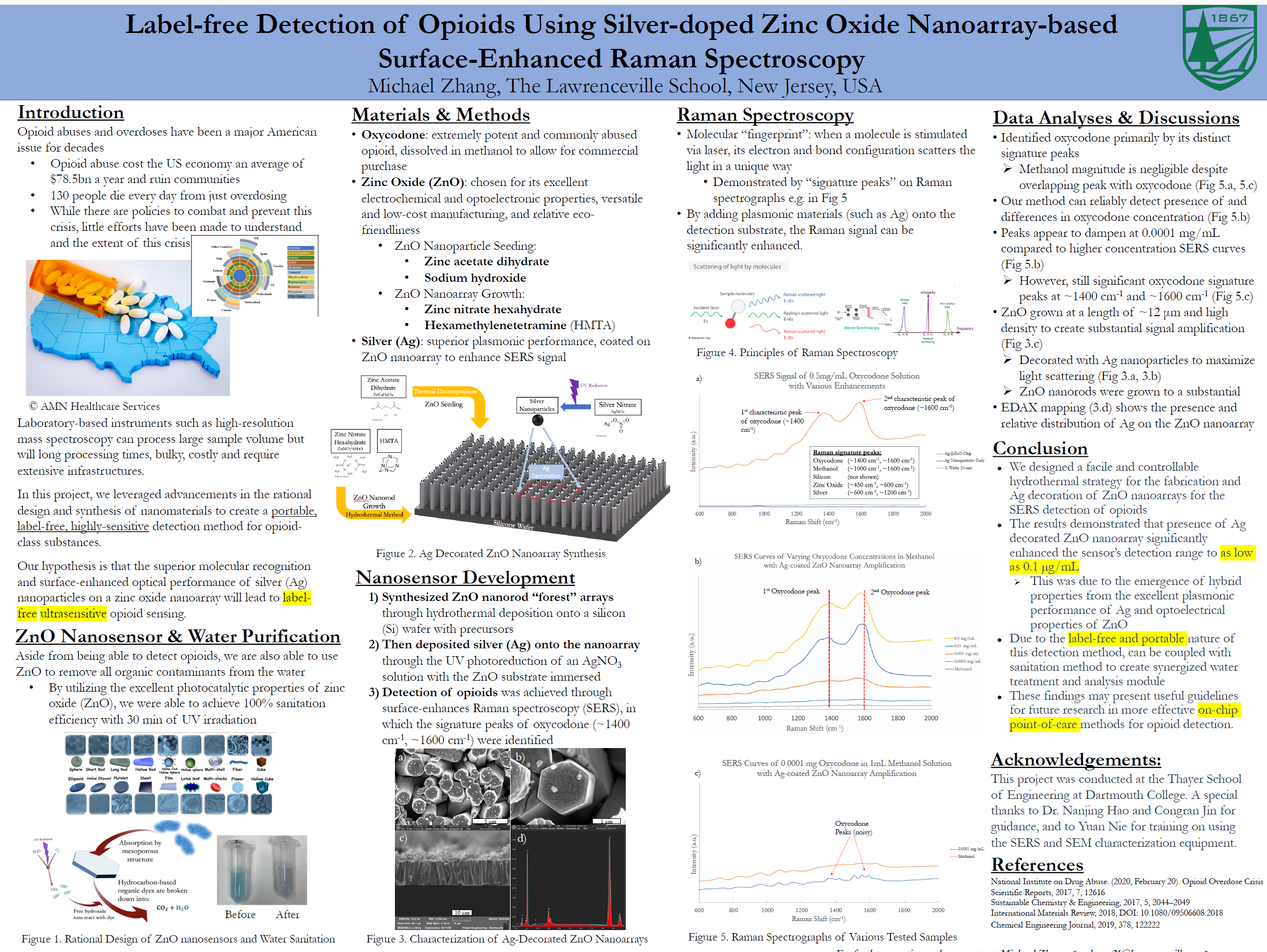Metal-doped Zinc Oxide Nanochip for Surface-Enhanced Raman Spectroscopic Sensing of Opioid in Water
Abstract:
Opioid abuse is a significant public health problem. Over two million Americans had an addiction to prescription or illicit opioids every year. While governmental programs have been established to treat overdoses and restrict opioid distribution, there are still very few predictive tools available to map and monitor such a crisis. In this project, we designed and fabricated zinc oxide (ZnO) nanorod arrays integrated-on-glass coverslips for the label-free detection of opioids.ZnO has become popular in biosensor applications due to its excellent electrochemical and optoelectronic properties, versatile and low-cost manufacturing, and relative eco-friendliness;However, ZnO-based structures have not been thoroughly studied as nanoscale chips for label-free point-of-care sensing. We focus on the Ag-decorated ZnO nanorod arrays grown on disposable glass coverslips and utilized them as efficient, label-free surface-enhanced Raman spectroscopy (SERS) sensors. These Ag-decorated ZnO nanorod arrays were synthesized via a custom facile hydrothermal growth procedure, and the resulting material structures were characterized using a scanning electron microscope (SEM) to validate the shape and dimensions.Given the restricted nature of pure opioid substances, we evaluated the nanochips’ opioid sensing performance on commercially-available opioid-containing solutions using Raman spectroscopy as a proof-of-concept study. Key experimental parameters such as growth parameters and physicochemical properties of ZnO nanorods were optimized, then we functionalized Ag nanoparticles on the ZnO nanorods surface to form the sensing element. Opioid-containing solutions at different concentrations (0.01 nM to 1μM) were tested using Raman spectroscopy to characterize nanochip sensitivity and specificity. In addition to drug screening, we have also demonstrated that we can utilize the highly efficient photocatalytic properties of ZnO nanostructures to decompose selected organic particles remaining in the water, which included, but was not limited to, the opioid compound being tested. Therefore, such ZnO nanochips could help to reveal remarkably detailed patterns of drug use while also providing a high-throughput water sanitation option. Our approach could give communities a powerful tool to detect emerging public health threats. The outcome of this project, combined with computational models, would also enable the connection of health data with different regions and populations, effectively allowing us to map the opioid crisis and develop more targeted, personalized, and efficient solutions.
Bibliography/Citations:
No additional citationsAdditional Project Information
Research Plan:
1. Synthesis of ZnO nanorod arrays on glass coverslips, this will be established by a two-step approach
(i) seeding of ZnO nanoparticles(NPs) on glass coverslips; and (ii) hydrothermal growth of ZnO nanorod arrays on the seeded ZnO-NPs. In the first step, 40mL of 2mM zincacetate dihydrate and 20 mL of 4 mM sodium hydroxide solutions were prepared separately in pure ethanol, and the solutions were stirred together to completely mix the chemicals. The mixture was placed in a 60°C oven for 2h to obtain a colloidal solution of ZnO NPs. 0.5 mL of the colloidal solution was placed on the glass coverslips and then used spin-coating to uniformly coat a layer of ZnO nanoseeds on coverslips surface. After seeding, 25 mL of aqueous growth solution, which includes 50 mM zinc nitrate hexahydrate and 25mM hexamethylenetetramine, was prepared in a 25 mL glass bottle, and ZnO nanoseeds-containing coverslips were immersed in growth solution in the same bottle. The glass bottle was then sealed and heated in an 86 °C oven for a certain period of time to allow the ZnO nanorods to grow.
2. Decoration of Ag nanoparticles on ZnO nanorod arrays
This process can be realized by a one-step UV irradiation of silver nitrate. In brief, 50 mM silver nitrate (0.5 mL) was dipped on the surface of ZnO nanorods-containing coverslips. After spin-coating treatment, the coverslips were placed under the irradiation of UV-lamp for 30 min. The coverslips were washed with water and then dried at 37 degree for further use.
3. Raman detection of opioid
As a proof-of-concept demonstration, opioid in saline at different concentrations (0.01 nM to 1μM) will be tested using Raman spectroscopy. If the results are promising, we may also try some clinical samples using urine, saliva, or human blood samples.

